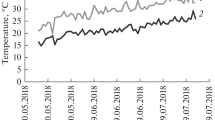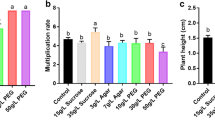Abstract
Hyperhydricity can cause significant loss in the in vitro propagated plantlets. In order to predict and control its occurrence, a better understanding of the structural aspects and physiological features of hyperhydric plantlets is required. In this study, the ultrastructural and physiological changes associated with hyperhydric red beet plantlets were investigated. Our objective was to establish a correlation between the ultrastructural aspects of Beta vulgaris var. Conditiva leaflets and hypocotyls and the content of chlorophyll pigments extracted in N,N-dimethylformamide (DMF) of two type of plantlets: hyperhydric from a basal culture medium Murashige and Skoog (JAMA 15:473–497, 1962) prepared with distilled water (DW—155 ppm Deuterium) and non-hyperhydric, cultivated on identical medium where distilled water was replaced with deuterium depleted water (DDW- 25 ppm Deuterium) as a method of preventing hyperhydricity. Cell ultrastructure in hyperhydricity, both from the leaves, but especially from hypocotyls, showed denatured chloroplasts in a myxoplasm mass formed by the damage of the tonoplast and the mixing of the cytoplasm with the vacuolar juice. The nuclei were picnotic, presenting paranucleolar corpuscles. The amount of assimilating pigments was significantly reduced in the plantlets grown on medium prepared with DW as compared to the normal, non-hyperhydric ones from medium prepared with DDW. Both evaluations showed that, in red beet, DDW also prevents the appearance of hyperhydricity.





Similar content being viewed by others
Abbreviations
- Ca :
-
Chlorophyll a
- Cb :
-
Chlorophyll b
- DMF:
-
N,N-dimethylformamide
- DW:
-
Distilled water
- DDW:
-
Deuterium depleted water
- MB-MS:
-
Basal medium Murashige–Skoog
- PAs:
-
Polyamines
References
Benson EE (2000) Special symposium: in vitro plant recalcitrance in vitro plant recalcitrance: an introduction. In Vitro Cell Dev Biol—Plant 36(3): 141–148. https://doi.org/10.1007/s11627-000-0029-z
Bisbis B, Dujardin E, Kevers C, Hagege D, Gaspar T (1994) Chlorophylls and carotenoids in a fully habituated nonorganogenic callus of Beta vulgaris. Biol Plant 36:443. https://doi.org/10.1007/BF02920947
Brand MH (1993) Agar and ammonium nitrate influence hyperhydricity, tissue nitrate and total nitrogen content of serviceberry (Amelanchier arborea) shoots in vitro. Plant Cell Tissue Organ Cult 35(3):203–209. https://doi.org/10.1007/BF00037271
Cachiţă CD, Crăciun C (1991) Vitrification and stress in carnation plantlets transferred from vitro, ex vitro, ultrastructural aspects. In: In vitro explant cultures - present and perspective. In: Proceedings of The IV-th National Symposium on Plant Cell and Tissue Culture, Cluj-Napoca, pp. 129–137
Cachiţă CD, Petruş CM, Petruş - Vancea A, Crăciun C (2008) Hyperhydricity phenomenon developed at the level of sugar beet (Beta vulgaris L. var. Saccharifera) vitrocultures. IV. Deuterium depleted water effects in hyperhydricity annihilation of vitroleaflet cells, aspects viewed to optic and transmission electronic microscope. Studia Univ Vasile Goldiş Seria Şt Vieţii 18(2):25–34. http://www.studiauniversitatis.ro/v15/vol-182008-othermenu-34
Cachiţă CD, Petruş - Vancea A, Crăciun C (2009) Issues regarding the chloroplast ultrastructure and assimilating pigments content in normal or hyperhydric sugar beet (Beta vulgaris L. var. Saccharifera) vitroplantlet leaflets. Studia Univ Vasile Goldiş Seria Şt Vieţii 19(2): 287–294. http://www.studiauniversitatis.ro/v15/vol-1922009
Chakrabarty D, Park SY, Ali MB, Shin KS, Paek KY (2006) Hyperhydricity in apple: ultrastructural and physiological aspects. Tree Physiol. 26(3):377–88. http://citeseerx.ist.psu.edu/viewdoc/download?doi=10.1.1.883.3613&rep=rep1&type=pdf
Da Ines O, Graf W, Franck KI, Albert A, Winkler JB, Scherb H, Stichler W, Schäffner AR (2010) Kinetic analyses of plant water relocation using deuterium as tracer – reduced water flux of Arabidopsis pip2 aquaporin knockout mutants. Plant Biol 12:129–139. https://doi.org/10.1111/j.1438-8677.2010.00385.x
de Klerk GJ, Pramanik D (2017) Trichloroacetate, an inhibitor of wax biosynthesis, prevents the development of hyperhydricity in Arabidopsis seedlings. Plant Cell Tissue Organ Cult 131:89–95. https://doi.org/10.1007/s11240-017-1264-x
Dewir YH, Indoliya Y, Chakrabarty D, Paek KY (2014) Biochemical and physiological aspects of hyperhydricity in liquid culture system. In: Paek KY, Murthy H, Zhong JJ. (eds) Production of biomass and bioactive compounds using bioreactor technology. Springer, Dordrecht, pp 693–670. https://doi.org/10.1007/978-94-017-9223-3_26
El-Dawayati MM, Zayed ZE (2017) Controlling hyperhydricity in date palm in vitro culture by reduced concentration of nitrate nutrients. In: Jameel M, Al-Khayri (eds) Date palm biotechnology protocols 1: Tissue culture applications, methods in molecular biology 1637, Springer ,Dordrecht, pp 175–183. https://doi.org/10.1007/978-1-4939-7156-5_15
Franck T, Kevers C, Hausman J-F, Dommes J, Penel C, Greppin H, Gaspar T (2000) Redox capacities of in vitro cultured plant tissues: the case of hyperhydricity. In: Driessche TV, Guisset JL, Petiau-de Vries GM (eds) The redox state and circadian rhythms. Springer, Dordrecht, pp 235–255. https://doi.org/10.1007/978-94-015-9556-8_13
Gao H, Li J, Ji H, An L, Xia X (2018) Hyperhydricity-induced ultrastructural and physiological changes in blueberry (Vaccinium spp.). Plant Cell Tissue Organ Cult 133:65–76. https://doi.org/10.1007/s11240-017-1361-x
Hayat MA (2000) Principles and techniques of electron microscopy. Biological applications, 4th edn. Cambridge University Press, Cambridge
Hendry GAF, Price AH (1993) Stress indicators: chlorophylls and carotenoids. In: Hendry GAF, Grime JP (eds) Methods in comparative plant ecology. Chapman & Hall, London, pp 148–152
Huang Y-C, Chiang C-H, Li C-M, Yu T-A (2011) Transgenic watermelon lines expressing the nucleocapsid gene of Watermelon silver mottle virus and the role of thiamine in reducing hyperhydricity in regenerated shoots. Plant Cell Tissue Organ Cult 106(1):21–29. https://doi.org/10.1007/s11240-010-9889-z
Ivanova M van Staden (2008) Effect of ammonium ions and cytokinins on hyperhydricity and multiplication rate of in vitro regenerated shoots of Aloe polyphylla. J Plant Cell Tissue Organ Culture 92(2):227–231. https://doi.org/10.1007/s11240-007-9311-7
Ivanova M van Staden (2009) Nitrogen source, concentration, and NH4+:NO3 – ratio influence shoot regeneration and hyperhydricity in tissue cultured Aloe polyphylla. Plant Cell Tissue Organ Cult 99(2):167–174. https://doi.org/10.1007/s11240-009-9589-8
Jakab ZI, Crăciun C (2009) Ultrastructural investigations concerning nucleolar formations (nab’s) encountered in meristematic tissues in Prunus domestica. Ann RSCB, 14(1): 51–57. http://www.annalsofrscb.ro/archive/14%201/06.pdf
Kadota M, Niimi Y (2003) Effects of cytokinin types and their concentrations on shoot proliferation and hyperhydricity in in vitro pear cultivar shoots. Plant Cell Tissue Organ Cult 72(3):261–265. https://doi.org/10.1023/A:1022378511659
Kevers C, Bisbis B, Franck T, Le Dily F, Huault C, Billard C, Foidart JM, Gaspar T (1997) On the possible causes of polyamine accumulation in in vitro plant tissues under neoplasic progression. In: Greppin H, Penel C, Simon P (eds) Travelling shot on plant development. Univ. of Geneva, Switzerland, pp 63–71
Kevers C, Franck T, Strasser RJ, Dommes J, Gaspar T (2004) Hyperhydricity of micropropagated shoots: A typically stress-induced change of physiological state. Plant Cell Tissue Organ Cult 77(2):181–191. https://doi.org/10.1023/B:TICU.0000016825.18930.e4
Lee YH, Kim HS, Kim MS, Kim Y-S, Joung H, Jeon J-H (2009) Reduction of shoot hyperhydricity in micropropagated potato plants via antisense inhibition of a chCu/ZnSOD gene. J Korean Soc Appl Biol Chem 52(4):397–400. https://doi.org/10.3839/jksabc.2009.070
Lucchesini M, Monteforti G, Mensuali-Sodi A, Serra G (2006) Leaf ultrastructure, photosynthetic rate and growth of myrtle plantlets under different in vitro culture conditions. Biol Plant 50(2):161–168. https://doi.org/10.1007/s10535-006-0001-9
Makunga NP, Jäger AK, van Staden J (2006) Improved in vitro rooting and hyperhydricity in regenerating tissues of Thapsia garganica L. Plant Cell Tissue Organ Cult 86(1):77–86. https://doi.org/10.1007/s11240-006-9100-8
Mayor ML, Nestares G, Zorzoli R, Picardi LA (2003) Reduction of hyperhydricity in sunflower tissue culture. Plant Cell Tissue Organ Cult 72(1):99–103. https://doi.org/10.1023/A:1021216324757
Moran R, Porath D (1980) Chlorophyll determinations in intact tissue using N,N-dimethylformamide. Plant Physiol 65:478–479. 0032–0889/80/65/0478/02/$00.50/0
Moyo M, Aremu AO (2015) Insights into the multifaceted application of microscopic techniques in plant tissue culture systems. Planta 242(4):773–790. https://doi.org/10.1007/s00425-015-2359-4
Murashige T, Skoog A (1962) Revised medium for rapid growth and bioassays with tobacco tissue cultures. Physiol Plant 15:473–497. https://doi.org/10.1111/j.1399-3054.1962.tb08052.x
Ochatt SJ, Muneaux E, Machado C, Jacas L, Pontécaill C (2002) The hyperhydricity of in vitro regenerants of grass pea (Lathyrus sativus L.) is linked with an abnormal DNA content. J Plant Physiol 159:1021–1028. https://doi.org/10.1078/0176-1617-00682
Ochatt SJ, Atif RM, Patat-Ochatt EM, Jacas L, Conreux C (2010) Competence versus recalcitrance for in vitro regeneration. Not Bot Hort Agrobot Cluj 38(2):102–108. https://doi.org/10.15835/nbha3824876
Ort D (2001) When there is too much light. Plant Physiol 125:29–32. https://doi.org/10.1104/pp.125.1.29
Pérez-Tornero O, Egea J, Olmos E, Burgos L (2001) Control of hyperhydricity in micropropagated apricot cultivars. In Vitro Cel Dev Biol—Plant 37(2):250–254. https://doi.org/10.1007/s11627-001-0044-8
Petruş - Vancea A, Radoveţ – Salinschi D, Cachiţă CD (2008) Hiperhydricity annihilation out of vitrocultures with deuterium depleted water and Pi water, using a double layer system. Proceeding of the International Symposium “New research in biotechnology” USAMV Bucharest, Serie F, Special Volume, Biotechnology, pp. 20–30. http://bioteh.usab.ro/site/Noutati/proceedings.pdf
Petruş-Vancea A (2011) New methods to improve the bioeconomic and ecoeconomic impact by plant biotechnology. Studia Universitatis “Vasile Goldiş”, Seria Ştiinţele Vieţii 21(3):587–591. http://www.studiauniversitatis.ro/pdf/21-2011/21-3-2011/SU21-3-2011-Petrus2.pdf
Sen A, Alikamanoglu S (2013) Antioxidant enzyme activities, malondialdehyde, and total phenolic content of PEG-induced hyperhydric leaves in sugar beet tissue culture. In Vitro Cel Dev Biol—Plant 49(4):396–404. https://doi.org/10.1007/s11627-013-9511-2
Tabart J, Franck T, Kevers C, Dommes J (2015) Effect of polyamines and polyamine precursors on hyperhydricity in micropropagated apple shoots. Plant Cell Tissue Organ Cult 120(1):11–18. https://doi.org/10.1007/s11240-014-0568-3
Teng WL, Liu Y-J (1993) Restricting hyperhydricity of lettuce using screen raft and water absorbent resin. Plant Cell Tissue Organ Cult 34(3):311–314. https://doi.org/10.1007/BF00029723
Tian J, Jian F, Wu Z (2015) The apoplastic oxidative burst as a key factor of hyperhydricity in garlic plantlet in vitro. Plant Cell Tissue Organ Cult 120:571–584. https://doi.org/10.1007/s11240-014-0623-0
Tsay HS, Lee CY, Agrawal DC, Basker S (2006) Influence of ventilation closure, gelling agent and explant type on shoot bud proliferation and hyperhydricity in Scrophularia yoshimurae— A medicinal plant. In Vitro Cell Dev Biol 42(5):445–449. https://doi.org/10.1079/IVP2006791
Vandemoortele J-L (1999) A procedure to prevent hyperhydricity in cauliflower axillary shoots. Plant Cell Tissue Organ Cult 56(2):85–88. https://doi.org/10.1023/A:1006254807948
Vinoth A, Ravindhran R (2015) Reduced hyperhydricity in watermelon shoots cultures using silver ions. In Vitro Cel Dev Biol—Plant 51(3):258–264. https://doi.org/10.1007/s11627-015-9698-5
Wang Y-L, Wang X-D, Zhao B, Wang Y-C (2007) Reduction of hyperhydricity in the culture of Lepidium meyenii shoots by the addition of rare earth elements. Plant Growth Regul 52(2):151–159. https://doi.org/10.1007/s10725-007-9185-z
Wellburn AR (1994) The spectral determination of chlorophylls a and b, as well as total carotenoids, using various solvents with spectrophotometers of different resolution. J Plant Physiol 144(3):307–313. https://doi.org/10.1016/S0176-1617(11)81192-2
Whitehouse AB, Marks TR, Edwards GA (2002) Control of hyperhydricity in Eucalyptus axillary shoot cultures grown in liquid medium. Plant Cell Tissue Organ Cult 71(3):245–252. https://doi.org/10.1023/A:1020360120020
Wu Z, Chen LJ, Long YJ (2009) Analysis of ultrastructure and reactive oxygen species of hyperhydric garlic (Allium sativum L.) shoots. In Vitro Cell Dev Biol—Plant 45(4): 483–490. https://doi.org/10.1007/s11627-008-9180-8
Yadav MK, Gaur A, Garg G (2003) Development of suitable protocol to overcome hyperhydricity in carnation during micropropagation. Plant Cell Tissue Organ Cult 72(2):153–156. https://doi.org/10.1023/A:1022236920605
Ziv M (1991) Vitrification: morphological and physiological disorders of in vitro plants. In: Debergh PC, Zimmerman RH (eds) Micropropagation. Springer, Dordrecht, pp 45–69. https://doi.org/10.1007/978-94-009-2075-0_4
Acknowledgements
In memoriam This article is dedicated to the memory of remarkable Dr. Constantin Crăciun, director of the Electron Microscopy Centre (EMC) of Babes-Bolyai University, Cluj-Napoca who invested a lot of enthusiasm and energy to electron microscopy and who initiated me in the mysteries of cell ultrastructure. The author also thanks Dr. Dorina Cachiță, from University of Oradea, for the mentoring activity in plant tissue culture and also to the EMC of Babes-Bolyai University’s Molecular Biology and Biotechnology Department (Cluj-Napoca, Romania) for the electron microscopy analysis.
Author information
Authors and Affiliations
Contributions
AP-V is responsible for the conception and design of all experiments, data analysis and manuscript editing.
Corresponding author
Ethics declarations
Conflict of interest
The author declares that she has no conflict of interest.
Research involving human and animal participants
No human participants and/or animals are involved in the research.
Additional information
Communicated by Sergio J. Ochatt.
Rights and permissions
About this article
Cite this article
Petruş-Vancea, A. Cell ultrastructure and chlorophyll pigments in hyperhydric and non-hyperhydric Beta vulgaris var. Conditiva plantlets, treated with deuterium depleted water. Plant Cell Tiss Organ Cult 135, 13–21 (2018). https://doi.org/10.1007/s11240-018-1439-0
Received:
Accepted:
Published:
Issue Date:
DOI: https://doi.org/10.1007/s11240-018-1439-0




